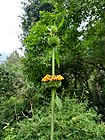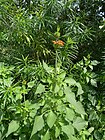Note: This is a project under development. The articles on this wiki are just being initiated and broadly incomplete. You can Help creating new pages.
Difference between revisions of "Leonotis nepetaefolia"
(→References) |
|||
| (4 intermediate revisions by the same user not shown) | |||
| Line 1: | Line 1: | ||
| − | + | [[File:Leonotis nepetifolia-2.JPG|thumb|right]] | |
| + | '''Leonotis nepetifolia''' is an annual or short-lived perennial plant growing from 1 - 3 metres tall. The stem is branched at the upper nodes only and the plant has an easily uprooted taproot about 10cm long. | ||
==Uses== | ==Uses== | ||
| − | {{Uses|}}, {{Uses|}}, {{Uses|}}, {{Uses|}}, {{Uses|}}, {{Uses|}}, {{Uses|}}, {{Uses|}}, {{Uses|}}, {{Uses|}}, {{Uses|}}.<ref name="Uses"/> | + | {{Uses|Swellings}}, {{Uses|Fever}}, {{Uses|Gastro-intestinal troubles}}, {{Uses|Diarrhoea}}, {{Uses|Heavy cramps}}, {{Uses|Bed-wetting}}, {{Uses|Piles}}, {{Uses|Thrush}}, {{Uses|Wounds}}, {{Uses|Itches}}, {{Uses|Skin diseases}}.<ref name="Uses"/> |
==Parts Used== | ==Parts Used== | ||
| − | {{Parts Used| | + | {{Parts Used|Flowers}}. |
==Chemical Composition== | ==Chemical Composition== | ||
| Line 10: | Line 11: | ||
==Common names== | ==Common names== | ||
| − | {{Common names|sa=|en=|gu=|hi=|kn=|ks=|ml=|mr=|pa=|ta=|te=}} | + | {{Common names|sa=Granthiparni|en=Lion's ear|gu=Lal guma|hi=Bara guma|kn=ದೆವ ತುಂಬೆ Deva tumbe, ಕಾಡು ತುಂಬೆ ಗಿಡ Kaadu tumbe gida|ks=|ml=|mr=Dipamaal|pa=|ta=Ranaperi|te=Hanumanthabeera}}<ref name="Common names"/> |
==Properties== | ==Properties== | ||
| Line 16: | Line 17: | ||
===Dravya=== | ===Dravya=== | ||
===Rasa=== | ===Rasa=== | ||
| − | |||
===Guna=== | ===Guna=== | ||
| Line 29: | Line 29: | ||
==Habit== | ==Habit== | ||
| − | {{Habit|}} | + | {{Habit|Perennial}} |
==Identification== | ==Identification== | ||
===Leaf=== | ===Leaf=== | ||
| − | {{Leaf|||}}<ref name="Leaf"/> | + | {{Leaf|Large|Ovate|Lobed, acute, Coarsely creanate serrate, Winged in the upper part and cuneate}}<ref name="Leaf"/> |
===Flower=== | ===Flower=== | ||
| − | {{Flower||||}} | + | {{Flower|Floral leaves lanceolate||||Deflexed, Bracts linear, stronlgy spinous pointed, deflexed, Calyx tubular}} |
===Fruit=== | ===Fruit=== | ||
| − | {{Fruit||||||}} | + | {{Fruit|Ovoid||4 nutlets|||}} |
===Other features=== | ===Other features=== | ||
| Line 48: | Line 48: | ||
==Mode of Propagation== | ==Mode of Propagation== | ||
| − | {{Propagation|}} | + | {{Propagation|Seeds}} |
==How to plant/cultivate== | ==How to plant/cultivate== | ||
| − | <ref name="How to plant/cultivate"/> | + | A pantropical weed. The plant forms dense thickets and is most abundant on heavily disturbed areas such as roadsides, overgrazed pastures and river levee banks.<ref name="How to plant/cultivate"/> |
==Commonly seen growing in areas== | ==Commonly seen growing in areas== | ||
| − | {{Commonly seen|}}, {{Commonly seen| | + | {{Commonly seen|A pantropical weed}}, {{Commonly seen|At roadsides}}. |
==Photo Gallery== | ==Photo Gallery== | ||
<gallery class="left" caption="" widths="140px" heights="140px"> | <gallery class="left" caption="" widths="140px" heights="140px"> | ||
| − | + | Leonotis nepetifolia, klip dagga, Christmas candlestick, or lion's ear.jpg | |
| + | Leonotis nepetifolia-1.JPG | ||
| + | Leonotis nepetifolia-2.JPG | ||
| + | Leonotis nepetifolia-3.JPG | ||
| + | Leonotis nepetifolia-4.JPG | ||
| + | Leonotis nepetifolia-5.JPG | ||
</gallery> | </gallery> | ||
| Line 64: | Line 69: | ||
<references> | <references> | ||
| − | <ref name="chemical composition">[ | + | <ref name="chemical composition">[Chemistry]</ref> |
| − | <ref name="Leaf"> | + | <ref name="Leaf">Kappatagudda - A Repertoire of Medicianal Plants of Gadag by Yashpal Kshirasagar and Sonal Vrishni, Page No. 255</ref> |
| + | <ref name="Common names">[https://sites.google.com/site/indiannamesofplants/via-species/l/leonotis-nepetifolia Common names]</ref> | ||
| − | <ref name="How to plant/cultivate">[ | + | <ref name="How to plant/cultivate">[http://tropical.theferns.info/viewtropical.php?id=Leonotis+nepetifolia Cultivation]</ref> |
<ref name="Uses">Indian Medicinal Plants by C.P.Khare</ref> | <ref name="Uses">Indian Medicinal Plants by C.P.Khare</ref> | ||
</references> | </references> | ||
==External Links== | ==External Links== | ||
| − | * [ ] | + | * [https://indiabiodiversity.org/species/show/230174 Leonotis nepetaefolia on indiabiodiversity.org] |
| − | * [ ] | + | * [https://keyserver.lucidcentral.org/weeds/data/media/Html/leonotis_nepetifolia.htm Leonotis nepetaefolia on keyserver.lucidcentral.org] |
| − | + | ||
[[Category:Herbs]] | [[Category:Herbs]] | ||
[[Category:Pages without herbs images]] | [[Category:Pages without herbs images]] | ||
Latest revision as of 14:04, 3 June 2021
Leonotis nepetifolia is an annual or short-lived perennial plant growing from 1 - 3 metres tall. The stem is branched at the upper nodes only and the plant has an easily uprooted taproot about 10cm long.
Contents
- 1 Uses
- 2 Parts Used
- 3 Chemical Composition
- 4 Common names
- 5 Properties
- 6 Habit
- 7 Identification
- 8 List of Ayurvedic medicine in which the herb is used
- 9 Where to get the saplings
- 10 Mode of Propagation
- 11 How to plant/cultivate
- 12 Commonly seen growing in areas
- 13 Photo Gallery
- 14 References
- 15 External Links
Uses
Swellings, Fever, Gastro-intestinal troubles, Diarrhoea, Heavy cramps, Bed-wetting, Piles, Thrush, Wounds, Itches, Skin diseases.[1]
Parts Used
Chemical Composition
Common names
| Language | Common name |
|---|---|
| Kannada | ದೆವ ತುಂಬೆ Deva tumbe, ಕಾಡು ತುಂಬೆ ಗಿಡ Kaadu tumbe gida |
| Hindi | Bara guma |
| Malayalam | |
| Tamil | Ranaperi |
| Telugu | Hanumanthabeera |
| Marathi | Dipamaal |
| Gujarathi | Lal guma |
| Punjabi | |
| Kashmiri | |
| Sanskrit | Granthiparni |
| English | Lion's ear |
Properties
Reference: Dravya - Substance, Rasa - Taste, Guna - Qualities, Veerya - Potency, Vipaka - Post-digesion effect, Karma - Pharmacological activity, Prabhava - Therepeutics.
Dravya
Rasa
Guna
Veerya
Vipaka
Karma
Prabhava
Habit
Identification
Leaf
| Kind | Shape | Feature |
|---|---|---|
| Large | Ovate | Lobed, acute, Coarsely creanate serrate, Winged in the upper part and cuneate |
Flower
| Type | Size | Color and composition | Stamen | More information |
|---|---|---|---|---|
| Floral leaves lanceolate | Deflexed, Bracts linear, stronlgy spinous pointed, deflexed, Calyx tubular |
Fruit
| Type | Size | Mass | Appearance | Seeds | More information |
|---|---|---|---|---|---|
| Ovoid | 4 nutlets |
Other features
List of Ayurvedic medicine in which the herb is used
Where to get the saplings
Mode of Propagation
How to plant/cultivate
A pantropical weed. The plant forms dense thickets and is most abundant on heavily disturbed areas such as roadsides, overgrazed pastures and river levee banks.[5]
Commonly seen growing in areas
A pantropical weed, At roadsides.
Photo Gallery
References
- ↑ Indian Medicinal Plants by C.P.Khare
- ↑ [Chemistry]
- ↑ Common names
- ↑ Kappatagudda - A Repertoire of Medicianal Plants of Gadag by Yashpal Kshirasagar and Sonal Vrishni, Page No. 255
- ↑ Cultivation
External Links
- Ayurvedic Herbs known to be helpful to treat Swellings
- Ayurvedic Herbs known to be helpful to treat Fever
- Ayurvedic Herbs known to be helpful to treat Gastro-intestinal troubles
- Ayurvedic Herbs known to be helpful to treat Diarrhoea
- Ayurvedic Herbs known to be helpful to treat Heavy cramps
- Ayurvedic Herbs known to be helpful to treat Bed-wetting
- Ayurvedic Herbs known to be helpful to treat Piles
- Ayurvedic Herbs known to be helpful to treat Thrush
- Ayurvedic Herbs known to be helpful to treat Wounds
- Ayurvedic Herbs known to be helpful to treat Itches
- Ayurvedic Herbs known to be helpful to treat Skin diseases
- Herbs with Flowers used in medicine
- Herbs with common name in Kannada
- Herbs with common name in Hindi
- Herbs with common name in Tamil
- Herbs with common name in Telugu
- Herbs with common name in Marathi
- Herbs with common name in Gujarathi
- Herbs with common name in Sanskrit
- Herbs with common name in English
- Habit - Perennial
- Index of Plants which can be propagated by Seeds
- Herbs that are commonly seen in the region of A pantropical weed
- Herbs that are commonly seen in the region of At roadsides
- Herbs
- Pages without herbs images






